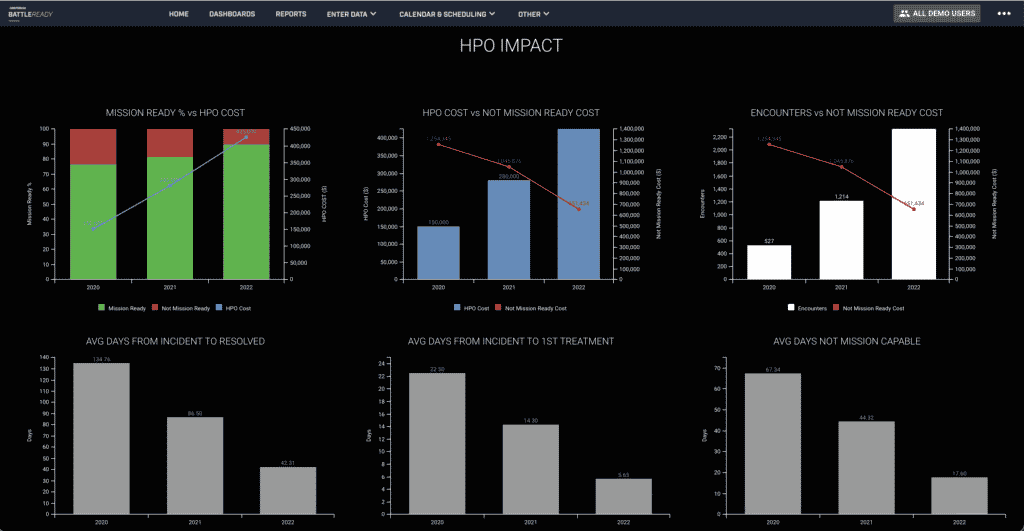In a previous post, we shared the steps military units can take to secure funding for their human performance (HP) programs, including designing and implementing a pilot program, finding the right budgetary sources, and supporting both the performance and the overall health of the warfighter. Now let’s turn our attention to how military organizations can use data visualization to demonstrate the impact of their program and the return on investment (ROI) it provides.
During a recent Fusion Sport webinar, Chief Master Sergeant (Ret.) Josh Smith and Fusion Sport’s Senior Consultant Dan Duffield explained why it’s essential to not only collect, manage, and act upon data in a human performance optimization (HPO) platform like Smartabase, but also to display and report on this information.
“We’ve learned to appreciate the value of visualizing the impacts against how money is being spent,” Dan said. “We’re helping the performance teams justify their existence. Return on investment data is really important because it doesn’t just show how we work toward the ultimate goal, but also why we need the resources at a tactical level.”

Increasing Warfighter Availability
Two of the main aims for any unit and the military as a whole are to have as many warfighters as possible be both available and mission ready/capable at any given time. When their availability, readiness, or both are compromised, there is a cost to that, and the overall mission capability declines.
Availability can be affected by numerous variables, but injury is arguably the greatest factor. Smartabase enables performance staff to log incidents in the system the moment they occur, record when the injured warfighter has their first encounter with a staff member, and note when their status changes from unavailable back to mission ready again. They can then visualize this in a dashboard to demonstrate the results of interventions over time. When these metrics are overlaid with the costs of the HPO program, decision-makers see the ROI represented in an intuitive, at-a-glance way.
Chief Master Sergeant (Ret.) Josh Smith, who utilized Smartabase as part of an HPO training program for Air Force candidates, shared why using such a platform can improve warfighter availability.
“Let’s say it used to take an average of 47 days for someone who was injured to get back out there and now it’s only taking 14,” he said. “That’s for two reasons. One, we have a system to capture injuries quicker, so they’re not as severe. Candidates aren’t holding their cards close to their chest until it’s so bad they can no longer take the pain. Two, we have the staff to re-implement them back into full-time training capability, so we’re seeing a lower reinjury rate.”
The HPO team can show the increased availability that Smith is referring to in several different ways, including a chart that displays a decrease in the number of days lost from when an incident was first logged to the moment that a warfighter is cleared to return to full active duty. The unit’s faster provision of treatment may be represented in a decline in the time it took from the point when an individual’s status change flagged their injury in Smartabase to the date of the first treatment.
In addition to displaying overall trends that demonstrate value, the flexible visualization tools in Smartabase also allow leaders to take a closer look at specific training courses. By zeroing in on certain types of injury and when they occurred, they are able to identify and fix issues in a way that mitigates the specific issue and reduces the total number of lost days when warfighters aren’t mission ready. They can then show this positive change in a dashboard.
“We’ve been able to find things we never would’ve thought of that have provided some good ROI,” Smith said. “For example, we saw there was a high rate of shoulder injuries on day five of an event. We still wanted to do it going forward, so we decided to sit the candidates on day three. Then they were a little more refreshed and weren’t as exhausted, and we saw the injury rate go down. Having the ability to lay out training courses allows us to dissect them. We’re using Smartabase to make risk management decisions.”
Improving Mission Readiness
Data visualization can help demonstrate the overall mission readiness of any military group in relation to its spending on human performance initiatives.
“The earlier you start running your program, the better,” Duffield said. “As you go into years two, three, and four, you can produce visuals for people at the leadership level to show, for example, that early on the cost to run the HPO program was $150,000 per year. Maybe that was two or three staff members and a little bit of technology. Then you can compare that to what the mission ready versus not mission ready rate was across that first year. As the funding increased, did we move the needle and see an increase in mission readiness? When the cost of the HPO program goes up because it’s getting more resources, comparing this to outcomes that the leadership cares about can justify the value.”
A system like Smartabase also allows staff to dive deeper and visualize how HPO efforts are impacting different roles. This doesn’t just relate back to dollars and cents in the budget, but also to on-the-ground decisions that help elevate readiness and, as a result, deliver greater value in the long run.
“You can look at the unit as a whole and see that its mission readiness is at 85 percent, which is pretty good,” Smith said. “But then the real beauty of Smartabase is that we can also look at the different jobs and see that one is only at 37 percent. It really helps Commanders focus on where the challenges are and which jobs need extra focus to get them above the minimum mission readiness rate. Seeing the data allows you to focus on those people who need the most attention, get them back above the healthy line, and keep them there. At the next level of leadership above a squadron, the Commander can click a button to look at the mission readiness of multiple units at the same time.”
During annual review meetings, the ability to run reports and visualize data demonstrate that an HPO program should not only receive ongoing funding but is delivering results that justify expansion and increased budget allocation.
Duffield explained how this could apply to the role-specific readiness that Smith mentioned. “If you had readiness stats in the 30s and 40s instead of the 80s and 90s, there could be so many factors influencing that. One could be that there’s no HP support there.” Whereas the jobs that have the highest scores may be those with the greatest level of engagement in the human performance initiative. This contrast could be illustrated in a Smartabase dashboard.
Another bar graph might show that within the jobs that now have the top levels of mission readiness, the more encounters they had with the HP staff, the lower the cumulative cost of not being mission ready became.
Considering Cognitive Load and Mental Health
As important as the physical preparation of warfighters is, their ability to function at a high level mentally is arguably just as crucial, particularly when they’re learning complex skills for technical roles or on a development pathway to one of the Special Forces. This can be another factor in overall readiness that can be influenced by gathering, reporting on, and visualizing data.
“We send all of our academic data into Smartabase so when there’s a failure, we can look at the five days leading up to that test, and see what someone’s sleep, hydration, and stress levels were,” Smith said. “For example, we had a soldier who kept failing the rope ladder climb. His performance training data showed that there was no physical reason why he shouldn’t be able to pass the rope climb. So we put a Zephyr puck on him and saw that by the time he got to the third rung, his heart rate was at 150. We determined it was a cognitive issue and were able to work with him on that. It’s the same with our weapons training.”
This is a microcosm example, but when such attention to detail and problem solving is repeated in different scenarios across an entire unit or class of candidates, overall readiness is bound to go up and can be demonstrated through data visualization.
Another component of mission readiness is mental health. This is something that initiatives like POTFF and the Air Force’s Whole Airman approach have prioritized in recent years, but it has traditionally proved difficult to capture data on warfighters’ mindsets. Smartabase enables HPO staff to not only gather such information but also display it to show the value of providing access to subject matter experts within an HPO framework and the subsequent impact on availability and mission readiness.
“It was amazing the first time I looked at the data from the psychology side,” Smith said. “I saw how much the number of encounters increased when we had psychologists right there on the actual team to work with people on a daily basis.”
Getting Leadership on Board with a Scalable Plan
In the military, units can secure initial funding for an HPO program, but to make it sustainable, they must be able to demonstrate immediate value and ongoing ROI.
“If you don’t have leadership – your O-6, O-7, or O-8 (Colonel, Brigadier General, or Major General) – behind you, you’re going to run into problems,” Smith said. “You can only fund this at the unit level for so long, and then you need to get it up into a program of record.”
Data visualization is a key component of getting such buy-in from unit Commanders, and then demonstrating the positive impact of the HPO initiative to higher-level leadership. Smith shared a potent example during the webinar:
We had an O-6 who had an incredible vision and told us to go ahead with the program, but when the one-star General found out about it, he wasn’t happy. We got summoned out of state to his office and it was his goal at the start of that meeting to shut it all down. But because we were able to show him the strategic roadmap and the benefits it would provide, he said, “You have 100 percent of my blessing – go do it.” You’ve got to have a plan and build it out looking at what your ultimate goal is, or you’re going to encounter huge roadblocks.
It can be difficult for military human performance teams to know which metrics to collect, combine, and visualize to demonstrate the true value of their program and how it is increasing availability, readiness, and overall warfighter wellbeing. This is where working with an experienced vendor can prove useful in transitioning from disparate data sources to collecting all HPO details in a single, centralized platform.
“Technology is becoming so complex, so having someone that can focus on that area for your HP team like Fusion Sport is going to end up increasing your ROI drastically,” Smith said. “There are going to be some significant cuts coming over the next couple of years if organizations can’t show what they’ve gained, like increasing deployability by 20 percent. If someone is trying to do this in Excel over 10 or 11 geographically dispersed locations, they’re not going to be able to capture that data and speak to the true value it provides like they would if they had a system like Smartabase.”
If You Enjoyed This Article, You Might Also Like…
- Webinar: The ROI of Human Performance Programs in the Military
- Securing Funding for Your Human Performance Program
- Podcast: Vanguard Roundtable – The Promise and Pitfalls of Injury Prediction
- How to Demonstrate the Effectiveness of Military Human Performance Programs
- Human Performance Solutions: Special Considerations for Military Implementations
- Course of Action for Your Military Human Performance Program








